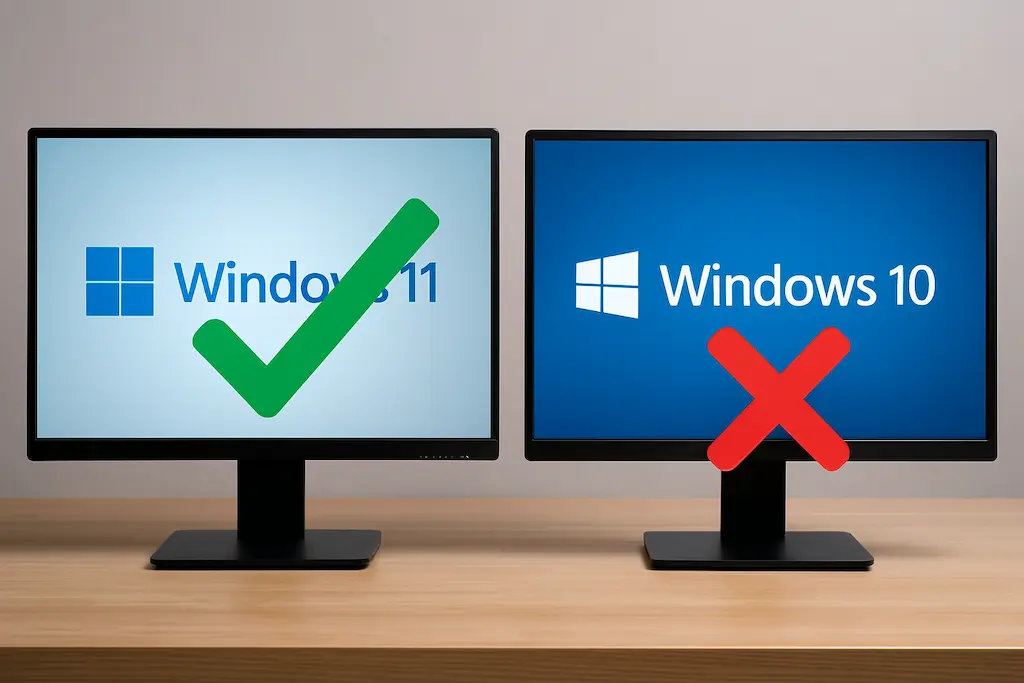The Windows 10 Countdown: Why Your Business Can't Afford to Wait

Introduction
As the digital landscape evolves at breakneck speed, businesses face a critical technological crossroads. On October 14, 2025—just over 18 months from now—Microsoft will end support for Windows 10, a milestone that demands attention from every organization still operating on this platform. This isn't merely a routine update cycle; it represents a fundamental shift in computing security, productivity, and innovation potential. The question isn't whether your business will transition to Windows 11, but whether you'll do so strategically or in crisis mode when support ends.
Is Windows 10 Holding You Back?
For many organizations, Windows 10 has been a reliable workhorse. However, beneath its familiar interface lies an increasingly outdated system struggling to keep pace with modern demands and emerging threats. The frustrations you've likely encountered aren't isolated incidents but symptoms of a system approaching its technological limits.
The Hidden Productivity Killers
The daily irritations of working with Windows 10 might seem minor in isolation, but collectively they extract a significant toll on productivity and morale. Consider these common pain points:
- Performance Degradation: What begins as occasional sluggishness eventually becomes the norm. Applications that once launched instantly now test your patience with extended load times. System resources become increasingly strained during multitasking, turning simple workflows into exercises in frustration.
- The Dreaded Blue Screen of Death: Few technological experiences match the stomach-dropping moment when your screen suddenly turns blue, announcing a system crash and potentially hours of lost work. Often triggered by driver conflicts or hardware compatibility issues, these crashes represent more than lost data—they erode confidence in your technology infrastructure.
- Connectivity Complications: In today's connected workplace, network reliability isn't optional. Windows 10 users frequently report Wi-Fi disconnections, printer recognition failures, and VPN connection issues that disrupt workflows and create unnecessary IT support tickets.
- Update Headaches: The very updates designed to improve Windows 10 often become sources of frustration. Failed installations, unexpected reboots during critical work periods, and post-update performance issues create a no-win situation: update and risk disruption, or delay and remain vulnerable.
The Growing Security Vulnerability
Beyond productivity concerns lies a more serious issue: security. As cyber threats grow increasingly sophisticated, Windows 10's security architecture—designed nearly a decade ago—struggles to provide adequate protection. After October 2025, this vulnerability will increase exponentially as Microsoft ceases security patches and updates.
The implications are sobering. In 2023 alone, businesses running outdated operating systems experienced 57% more security breaches than those using current versions. Without ongoing security updates, Windows 10 systems will become prime targets for cybercriminals seeking the path of least resistance.
Unlock a Better Experience with Windows 11
Windows 11 isn't merely an aesthetic refresh of its predecessor—it represents a fundamental reimagining of what a modern operating system should be. From its security architecture to its productivity features and AI integration, Windows 11 offers substantial improvements that address the very pain points businesses experience with Windows 10.
Fortified Security: A Foundation of Protection
Windows 11's approach to security begins at the hardware level, establishing a significantly more robust defense against modern threats. This isn't about incremental improvements but a comprehensive security redesign:
- Hardware-Based Security: The mandatory implementation of Trusted Platform Module (TPM) 2.0 creates a secure vault for storing cryptographic keys, protecting against firmware and hardware-level attacks. Unlike Windows 10, where TPM 2.0 was optional, Windows 11 makes this critical security feature a requirement.
- Virtualization-Based Security (VBS): Windows 11 creates an isolated, virtualized memory region where critical security processes operate protected from the rest of the system. This isolation prevents malicious code from compromising essential security functions even if other parts of the system are breached.
- Hypervisor-Protected Code Integrity (HVCI): This feature ensures that only trusted, verified code can run in kernel mode—the core of the operating system. By preventing unauthorized code execution at this fundamental level, HVCI blocks sophisticated attacks that attempt to manipulate the system's most critical operations.
- Smart App Control: This intelligent security layer screens applications before they run, leveraging cloud-based intelligence to identify and block malicious software. Unlike traditional antivirus solutions that react to known threats, Smart App Control proactively prevents potentially harmful applications from executing in the first place.
- Microsoft Pluton Security Processor: Available on newer Windows 11 devices, this processor is embedded directly within the PC's CPU, providing hardware-level protection for sensitive information including credentials and encryption keys. This integration simplifies security management while strengthening defenses against sophisticated attacks.
The contrast with Windows 10 is stark. Recent security incidents highlight the growing vulnerability of Windows 10 systems, including an actively exploited vulnerability in the Windows Common Log File System Driver for which a patch was not immediately available for Windows 10 32-bit or 64-bit systems. Such incidents underscore the increasing risks of relying on an operating system approaching end-of-life.
Enhanced Productivity: Working Smarter, Not Harder
Beyond security, Windows 11 introduces thoughtful productivity enhancements designed to streamline workflows and reduce friction in daily tasks:
- Intuitive File Management: The redesigned File Explorer finally brings tabbed browsing to file management, eliminating the need to juggle multiple Explorer windows. Its streamlined toolbar with clearly labeled icons for common commands makes everyday file operations more accessible and efficient.
- Snap Layouts and Snap Groups: These features transform multitasking from a chaotic window-arranging exercise into an organized system. Snap Layouts provide predefined window arrangements for optimal screen utilization, while Snap Groups save these configurations for instant recall, allowing seamless switching between different sets of applications.
- Virtual Desktops 2.0: For users juggling multiple projects or contexts, Windows 11's improved Virtual Desktops feature allows the creation of distinct desktop environments on a single device. Each virtual desktop can have its own wallpaper and application set, creating visual separation between work modes and minimizing distractions.
- Streamlined Settings: The redesigned Settings app features a persistent left-hand navigation menu for easier category switching, while the Quick Settings menu provides instant access to commonly used system controls like Wi-Fi, Bluetooth, and volume adjustments.
- Teams Integration: With Microsoft Teams Chat directly accessible from the taskbar, initiating conversations, joining meetings, and collaborating with colleagues becomes seamless—particularly valuable for businesses embracing hybrid work models.
These productivity enhancements aren't merely cosmetic changes; they address fundamental workflow inefficiencies that cost businesses countless hours of productivity. The intuitive design reduces the learning curve for new users while providing experienced users with powerful tools to manage increasingly complex digital workloads.
Experience the Difference: Speed and Intelligence
Performance Unleashed
Windows 11 delivers noticeable performance improvements in several key areas:
- Faster Boot Times: Windows 11 is engineered for quicker startup, getting users to their desktop and productive work more rapidly.
- Optimized Resource Management: The system more intelligently allocates resources to foreground applications, resulting in smoother multitasking and improved responsiveness during intensive workloads.
- Enhanced Battery Life: For mobile workers, Windows 11's improved power management extends battery life, enabling greater productivity away from power outlets.
- Gaming Enhancements: Features like Auto HDR and DirectStorage significantly improve gaming experiences, with the latter technology also benefiting data-intensive business applications through faster storage access.
While benchmark comparisons between Windows 10 and 11 show varying results depending on hardware configurations and specific tasks, Windows 11's modern architecture is increasingly optimized for contemporary computing needs. Moreover, as hardware manufacturers design new systems specifically to leverage Windows 11's capabilities, the performance gap will likely continue to widen in Windows 11's favor.
The Power of AI at Your Fingertips
Perhaps the most compelling reason to upgrade is Windows 11's deep integration of artificial intelligence across the operating system—a transformative approach that Windows 10 simply cannot match:
- Microsoft Copilot: Accessible directly from the taskbar, this AI assistant helps with content generation, workflow automation, and system navigation. From drafting emails to summarizing documents and troubleshooting problems, Copilot brings AI assistance directly into your daily workflow.
- AI-Enhanced Creativity Tools: Built-in applications leverage AI to expand creative possibilities. The Paint app's Cocreator feature generates unique artwork based on text prompts and sketches, while the Photos app uses AI for advanced editing capabilities like generative erase (removing unwanted elements) and super resolution (enhancing image quality).
- Accessibility Through AI: Features like Live Captions provide real-time, system-wide transcription of any audio content—invaluable for users with hearing impairments and in situations where audio cannot be played. Windows Studio Effects uses AI to enhance video conferencing with automatic background blur and eye contact correction.
- The Future with Recall: This innovative feature (available on specific hardware) employs AI-powered search to help users quickly find virtually any content they've previously viewed on their PC, creating a searchable visual history of computing activity.
These AI integrations represent more than novelty features—they're productivity multipliers that can dramatically reduce time spent on routine tasks while enhancing creativity and accessibility. As AI continues to evolve, Windows 11's architecture is designed to incorporate these advancements, future-proofing your technology investment.
Making the Upgrade Smooth and Affordable
Is Your System Ready?
Before embarking on the upgrade journey, it's essential to assess your current hardware's compatibility with Windows 11. The system requirements include:
- 1 GHz or faster processor with 2+ cores
- 4 GB RAM minimum (8 GB recommended)
- 64 GB or larger storage
- UEFI system firmware with Secure Boot capability
- Trusted Platform Module (TPM) version 2.0
- DirectX 12 compatible graphics
Microsoft's free PC Health Check app provides a comprehensive assessment of your system's readiness for Windows 11. While it's technically possible to bypass these requirements through registry modifications or third-party tools, doing so is generally inadvisable as it may lead to system instability and the risk of not receiving future security updates.
Common upgrade challenges include hardware incompatibility (particularly with older processors), driver issues, insufficient disk space, and conflicts with third-party software. To mitigate these potential problems:
- Ensure your Windows 10 system is fully updated
- Check for and install the latest hardware drivers
- Uninstall unnecessary third-party software, especially security suites
- Back up all critical data before beginning the upgrade process
Smart Budgeting for a Seamless Transition
Rather than facing a substantial one-time expense as the October 2025 deadline approaches, consider adopting a phased technology upgrade strategy. This approach distributes costs over time while minimizing operational disruption.
For example, a business with 20 computers could implement the following upgrade schedule: Around 3 computers per month. This will make budgeting much easier on the bank account.
The Expert Verdict: Act Now or Pay Later
Technology experts and industry publications overwhelmingly recommend upgrading from Windows 10 to Windows 11 before the October 2025 support deadline. The primary driver for this recommendation is cybersecurity—continuing to use Windows 10 without security updates will leave systems highly vulnerable to evolving threats.
Beyond security, Windows 11's productivity enhancements, support for modern work environments including hybrid models, and AI integration position your business for future technological advancements. While the initial upgrade to Windows 11 is free for compatible devices, the long-term benefits in enhanced security, improved productivity, and future readiness make it a sound investment even when hardware upgrades are necessary.
The question isn't whether your business will transition from Windows 10—it's whether you'll do so proactively and strategically or reactively when forced by circumstances. By beginning your migration planning now, you can:
- Spread costs over multiple budget cycles
- Minimize operational disruption through phased implementation
- Provide adequate time for staff training and adaptation
- Identify and address compatibility issues with critical business applications
- Begin realizing productivity and security benefits immediately
Don't wait until the last minute to address this inevitable transition. With October 2025 rapidly approaching, now is the time to develop a comprehensive Windows 11 migration strategy that aligns with your business objectives and budget constraints. The businesses that approach this transition strategically will transform what could be a technological crisis into a competitive advantage.
